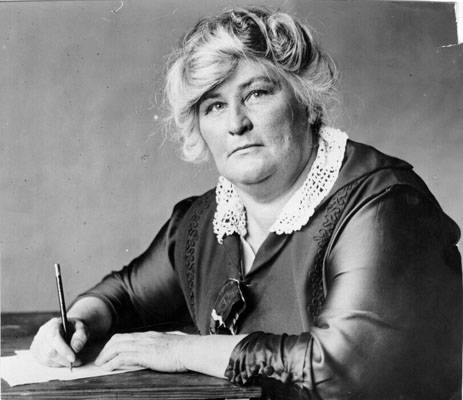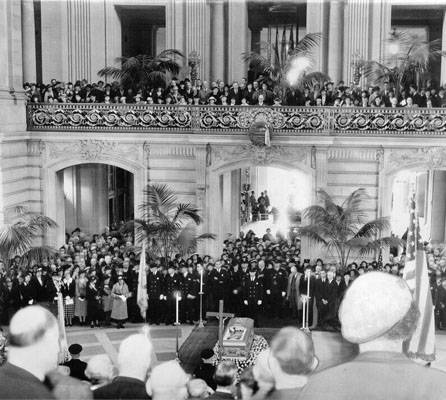Winifred Bonfils - journalist: Difference between revisions
No edit summary |
(photos added) |
||
| Line 1: | Line 1: | ||
'''<font face = arial light> <font color = maroon> <font size = 3>Unfinished History</font></font> </font>''' | '''<font face = arial light> <font color = maroon> <font size = 3>Unfinished History</font></font> </font>''' | ||
[[Image:Annie Laurie nd AAA-5698.jpg]] | |||
Bonfils was the daughter of Civil War General Benjamin Sweet. After writing to the Chicago Tribune, she was hired for a short time then in 1890 she found work at the [[San Francisco Examiner]]. | '''Winifred Bonfils, aka Annie Laurie, n.d.''' | ||
''Photo: San Francisco History Center, SF Public Library'' | |||
'''Winifred Sweet Black Bonfils (October 14, 1863, Chilton, Wisconsin – May 25, 1936, San Francisco, California)''' was an American reporter and columnist for [[William Randolph Hearst]]'s news syndicate writing as Winifred Black, and for the ''San Francisco Examiner'' as Annie Laurie. She was one of the most prominent "sob sisters", a label given female reporters who wrote human interest stories. Her first husband was Orlow Black, and her second was publisher Charles Bonfils. | |||
Bonfils was the daughter of Civil War General Benjamin Sweet. After writing to the Chicago Tribune, she was hired for a short time then in 1890 she found work at the ''[[San Francisco Examiner]]''. | |||
[[Image:Jan 5 1932 annie laurie with mayor rossi and chief quinn AAA-5689.jpg]] | |||
'''Annie Laurie with Mayor Rossi and Police Chief Quinn, Jan. 5, 1932.''' | |||
''Photo: San Francisco History Center, SF Public Library'' | |||
She became famous after staging a fainting on the street in San Francisco to test emergency services, which were found wanting, resulting in a major scandal and institution of ambulance service. In 1900, she dressed as a boy and was the first reporter on the line at the Galveston Hurricane. She delivered an exclusive and Hearst sent relief supplies by train. Later she wrote a biography of Phoebe Apperson Hearst. | She became famous after staging a fainting on the street in San Francisco to test emergency services, which were found wanting, resulting in a major scandal and institution of ambulance service. In 1900, she dressed as a boy and was the first reporter on the line at the Galveston Hurricane. She delivered an exclusive and Hearst sent relief supplies by train. Later she wrote a biography of Phoebe Apperson Hearst. | ||
The name "Annie Laurie" was a tribute to her contemporary Nellie Bly. Her funeral was nearly a state event in San Francisco. | The name "Annie Laurie" was a tribute to her contemporary Nellie Bly. Her funeral was nearly a state event in San Francisco. | ||
[[Image:Funeral of annie laurie 1936 AAA-5641.jpg]] | |||
'''Funeral of Annie Laurie, June 2, 1936, San Francisco City Hall''' | |||
''Photo: San Francisco History Center, SF Public Library'' | |||
'''Quotes''' | '''Quotes''' | ||
| Line 19: | Line 37: | ||
"I like newspapers and newspaper people and newspaper standards, and I like newspaper news too, and I'm just foolish enough to say so. . . . I'm proud of being, in a very humble way, a member of the good old newspaper gang — the kindest-hearted, quickest-witted, clearest-eyed, most courageous assemblage of people I have ever had the honor and the good fortune to know. . . ." | "I like newspapers and newspaper people and newspaper standards, and I like newspaper news too, and I'm just foolish enough to say so. . . . I'm proud of being, in a very humble way, a member of the good old newspaper gang — the kindest-hearted, quickest-witted, clearest-eyed, most courageous assemblage of people I have ever had the honor and the good fortune to know. . . ." | ||
[[category:media]] [[category:newspapers]] [[category:1900s]] | [[category:media]] [[category:newspapers]] [[category:1900s]] [[category:1930s]] [[category:women]] | ||
Revision as of 15:13, 20 March 2009
Unfinished History
Winifred Bonfils, aka Annie Laurie, n.d.
Photo: San Francisco History Center, SF Public Library
Winifred Sweet Black Bonfils (October 14, 1863, Chilton, Wisconsin – May 25, 1936, San Francisco, California) was an American reporter and columnist for William Randolph Hearst's news syndicate writing as Winifred Black, and for the San Francisco Examiner as Annie Laurie. She was one of the most prominent "sob sisters", a label given female reporters who wrote human interest stories. Her first husband was Orlow Black, and her second was publisher Charles Bonfils.
Bonfils was the daughter of Civil War General Benjamin Sweet. After writing to the Chicago Tribune, she was hired for a short time then in 1890 she found work at the San Francisco Examiner.
Annie Laurie with Mayor Rossi and Police Chief Quinn, Jan. 5, 1932.
Photo: San Francisco History Center, SF Public Library
She became famous after staging a fainting on the street in San Francisco to test emergency services, which were found wanting, resulting in a major scandal and institution of ambulance service. In 1900, she dressed as a boy and was the first reporter on the line at the Galveston Hurricane. She delivered an exclusive and Hearst sent relief supplies by train. Later she wrote a biography of Phoebe Apperson Hearst.
The name "Annie Laurie" was a tribute to her contemporary Nellie Bly. Her funeral was nearly a state event in San Francisco.
Funeral of Annie Laurie, June 2, 1936, San Francisco City Hall
Photo: San Francisco History Center, SF Public Library
Quotes
"a woman has a distinct advantage over a man in reporting if she has sense. . . . Men always are good to women."
On the label, sob-sister, "Most of them are sap sisters."
"I'd rather smell the printer's ink and hear the presses go around than go to any grand opera in the world."
"I like newspapers and newspaper people and newspaper standards, and I like newspaper news too, and I'm just foolish enough to say so. . . . I'm proud of being, in a very humble way, a member of the good old newspaper gang — the kindest-hearted, quickest-witted, clearest-eyed, most courageous assemblage of people I have ever had the honor and the good fortune to know. . . ."



